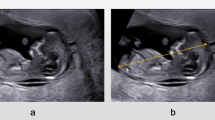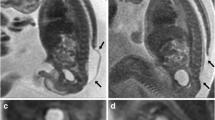Abstract
Background
Objective assessment of posterior fossa landmarks such as the measurement of brain stem width or intracranial translucency have not been consistently shown to be predictive of future posterior fossa abnormalities, other than the Arnold–Chiari II malformation.
Objective
To study the association between the objective and subjective assessments of the posterior fossa landmarks at the 11–14 weeks’ scan and the posterior fossa abnormalities detected at the second-trimester anomaly scan.
Methods
Design—Blinded retrospective case–control study. Setting—Tertiary level multioperator fetal medicine center. Cases-fetuses with one of the second trimester diagnoses of posterior fossa abnormalities (Blake’s pouch cyst, mega cisterna magna, vermian agenesis, Dandy–Walker malformation, cerebellar hypoplasia) that had a 11–14 weeks’ examination at our center; Controls-fetuses with normal second trimester anatomy that had a 11–14 weeks’ examination at our center. Main outcome measures: measurements of the posterior fossa landmarks and subjective assessment of the landmarks.
Results
Significant inter-rater agreement existed for three out of four measurements of posterior fossa landmarks. No significant difference was noted in the measurements between cases and controls, in fetuses with measurable landmarks. Abnormal landmarks were more in cases than controls (brainstem OR 4.2 (95% CI 1.5–11.8); intracranial translucency OR 3.7 (95% CI 1.3–10.1); any landmark OR 3.1 (95% CI 1.2–7.9).
Conclusion
Abnormal posterior fossa landmarks at the 11–14 weeks’ examination is associated with threefold risk of posterior fossa malformation.



Similar content being viewed by others
References
Pandya PP, Snijders RJ, Johnson SP, De Lourdes Brizot M, Nicolaides KH. Screening for fetal trisomies by maternal age and fetal nuchal translucency thickness at 10 to 14 weeks of gestation. Br J Obstet Gynaecol. 1995;102(12):957–62.
Salomon LJ, Alfirevic Z, Bilardo CM, Chalouhi GE, Ghi T, Kagan KO, et al. ISUOG practice guidelines: performance of first-trimester fetal ultrasound scan. Ultrasound Obstet Gynecol Off J Int Soc Ultrasound Obstet Gynecol. 2013;41(1):102–13.
Chaoui R, Nicolaides KH. From nuchal translucency to intracranial translucency: towards the early detection of spina bifida. Ultrasound Obstet Gynecol Off J Int Soc Ultrasound Obstet Gynecol. 2010;35(2):133–8.
Volpe P, Contro E, Fanelli T, Muto B, Pilu G, Gentile M. Appearance of fetal posterior fossa at 11–14 weeks in fetuses with Dandy–Walker malformation or chromosomal anomalies. Ultrasound Obstet Gynecol Off J Int Soc Ultrasound Obstet Gynecol. 2016;47(6):720–5.
Lachmann R, Sinkovskaya E, Abuhamad A. Posterior brain in fetuses with Dandy–Walker malformation with complete agenesis of the cerebellar vermis at 11–13 weeks: a pilot study. Prenat Diagn. 2012;32(8):765–9.
Chaoui R, Nicolaides KH. Detecting open spina bifida at the 11–13-week scan by assessing intracranial translucency and the posterior brain region: mid-sagittal or axial plane? Ultrasound Obstet Gynecol Off J Int Soc Ultrasound Obstet Gynecol. 2011;38(6):609–12.
Ergin RN, Yayla M. The nomogram of intracranial translucency in the first trimester in singletons. J Turk Ger Gynecol Assoc. 2012;13(3):153–6.
Acknowledgements
Supported by a grant from Fetal Care Research Foundation, a public charitable trust, Chennai, India.
Author information
Authors and Affiliations
Corresponding author
Ethics declarations
Conflict of interest
None.
Rights and permissions
About this article
Cite this article
Ponmozhi, G., Manikandan, K., Gopish, D. et al. Beyond Open Neural Tube Defects: Sagittal Landmarks at 11–14 Weeks in the Prediction of Second Trimester Posterior Fossa Abnormalities. J. Fetal Med. 4, 31–36 (2017). https://doi.org/10.1007/s40556-017-0113-7
Received:
Accepted:
Published:
Issue Date:
DOI: https://doi.org/10.1007/s40556-017-0113-7




